It is at work everywhere, functioning smoothly at times, at others in fits and starts: an urban process in which things designed for one particular function are used for another. A standard stock of materials suddenly confronts a logic of construction that reinterprets it completely in uses and contexts that were never imagined for it. At times, this combinatorial propensity—even promiscuity—lying dormant in various artifacts and materials is fired up to such a degree that the apparent inevitability of established typologies and uses are undermined completely.
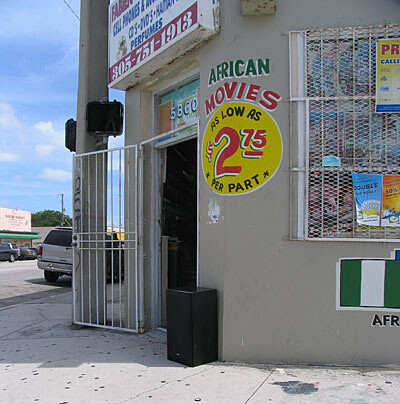

Individuals with no or limited connection to each other—in terms of the merchandise they offer, the clientele they cater to, or, in certain cases, in terms of nationality and ethnicity—perform the same gesture: every morning they drag a speaker out their front door and crank up the music. This gesture forms part of a bank of local knowledge that is itself a negotiation between imported habits (putting speakers in front of stores) and what the city allows (speakers that remain seemingly impermanent or extractable elements of the commercial structure). If a photographic map of the commercial axis of Northeast 2nd Avenue in Miami’s Little Haiti neighborhood were to show all locations where speakers are placed on sidewalks in front of businesses, a number of observations could be made.
A pair of produce bins from the 99-cent store are tied together to make a protective casing for the speakers that a shop owner drags every morning to the sidewalk in front of his business. Elsewhere, the seats of discarded chairs are collected over a couple of months and glued to a set of milk crates to produce a makeshift social space for afternoon domino games under a blooming Poinciana tree in a backyard. These are examples of a process that is activated so often that to continue to approach the phenomenon as a series of isolated instances—as this or that retrofitted object or clever solution—is to miss the point. What we have here is a system, even if a self-organized and improvised one, that spontaneously reshapes urban spaces. The way that certain retrofitted and updated objects—not to speak of graphics and languages—found in immigrant and marginalized neighborhoods in cities throughout the West effectively alter urban morphologies and patterns of behavior cannot help but push us to think of them beyond individual instances. The density of examples adds up to a force of urban reconfiguration. Though these unexpected objects are usually produced by individuals responding to isolated needs one design decision at a time, it is when these endeavors are considered collectively that we start to see this collection of solutions synthesizing into a vital urban force.
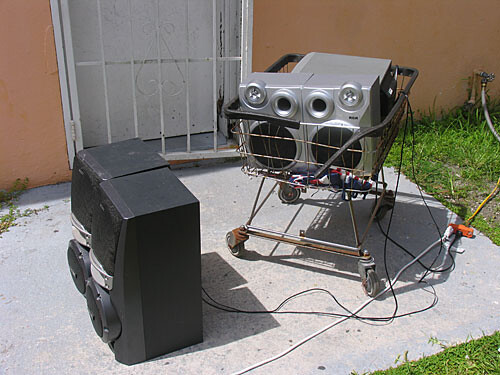

The purpose of the speakers is obvious: they are there to attract the attention of passers-by. But they must achieve this aim, which is identical to that of commercial signage, in such a way as to elude both the legal constraints that demand that signage follow certain norms (such as the request for permits and the payment of fees) and the more cumbersome economic one that places signage production in the hands of a specialized group of professional sign manufacturers, who themselves have to fulfill certain legal requirements, such as having state licenses and active insurance policies, and who demand remuneration in line with the standards of their field. This doesn’t mean that these businesses don’t have any signage. There is a kind of homemade graphic painted directly on the exterior walls of most of these shops. But what they lack is a sign-object, a light box or neon sign. Homemade graphics cannot provide what the sign-object can: an expanded visual representation, a way to invade the surrounding public spaces. But the speaker makes up the difference by projecting the business outward. It reverses the hierarchy of the visual over the auditive, and in the process betrays a certain mistrust of the former as compared to the latter: it harks back to the vendor’s cry and other vernacular processes of the marketplace that defy the line-of-sight geometries that the visual requires. As the message of a lit neon sign or a light box can be said to spread out visually, so the music pumping out of the speaker spreads out sonically, only it can turn corners, traverse walls, and climb over obstacles.
This is why a snapshot of a milk crate at the moment in its life-cycle when it transitions from one use to another—when it is stolen from the supermarket and used as the leg of a display table for pirated DVDs—can be a better model for urban reconfiguration than a Herzog & de Meuron building caught in a sweeping shot from a helicopter or in a vertiginous 3D zoom. This snapshot neatly captures the fact that a city’s morphology is as prone to alteration by small and repetitive gestures as it is by megaprojects. In time, such small gestures at the level of everyday objects can acquire a profound density in their collective effect on urban textures and grammars, and say something about the scale at which a city is to be imagined and realized.
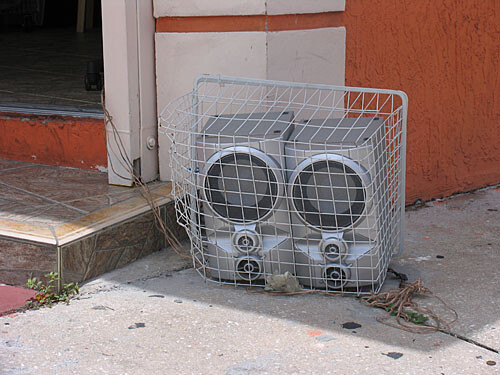

Just as the music emanating from these speakers can be said to invade public space virtually, there is a physical invasion that accompanies it. The speakers are literally placed on public sidewalks. And with the speakers, a number of other elements are also brought out. Plants in shopping carts, sugar canes in milk crates, bouquets of brooms stuffed in trash cans, fully-dressed mannequins, exercise equipment, belt racks, chairs, clothing, flags, local newspapers, overstocked soft drinks, and all kinds of merchandise spill out beyond the shop’s walls, beyond its architectural limitations. A schematic drawing of this speaker would have to include not only the actual object, but the wiring with which it connects to the city, the systems on which it is mounted for easy transportation, the systems it is inserted into for protection. It is the combination of these three elements with the object of the speaker as a particular entity that distinguishes its use and treatment in the context of this neighborhood from how it might be understood elsewhere. If it is co-extensive with the systems into which it is introduced, it is an assemblage that folds into an even larger mise en scène that it constitutes along with the other objects (which are themselves assemblages, composed, for example, of the sugar canes in the milk crate or the plants in the shopping cart). So mannequin, merchandise, speaker, the homemade graphics, the typical (and typically patterned) bars on the windows, as well as the darkness of the space’s interiors, together form larger expressive units. Beyond simple display structures, they generate new territorial and identity markers: they are a scenery that diagrams not only the merchandise available in the store, but a certain cleverness in relation to the burdens presented by the neighborhood and the city.
As industries shift from standardization to optimization, as cities move from the physical to the virtual, traditional approaches to urban planning have become obsolete. In essence, cities now change and grow below the threshold of visibility associated with architecture and urbanism. Information networks, Wi-Fi hotspots, fiber-optic grids, traffic fluctuation, crime rates, tax schemes, zoning regulations, ordinances and other legal constraints—all these matter as much, and often more than, the actual buildings around which they circulate. Consequently, certain designers have argued for decades that urbanism should begin at the level of the object. Already in 1988, Andrea Branzi proposed that this shift implies a new metropolitan theorem:
This theorem recognizes that changes in the metropolis take place not only through the construction of architectural structures, road systems or urban services, but also through the renewal of the systems of objects and the individual commodities that improve and transform the cultural and technical fitness of places for habitation, creating the city of the present inside that of the past and the city of the future inside the present one.1
As the non-architectural becomes a central component in the alterations that cities have undergone, entirely new cities emerge within the shells of buildings that speak to the concerns of another time.


Although the speakers are employed to call attention to the business, they must remain “unnoticed”—seen and heard, but not as permanent elements used to augment the traffic of consumers (and the profitability of the business). They are not to be understood as part of its intrinsic promotional machinery, even if this is precisely what they are. They should appear to be employed primarily for the entertainment they provide. Entertainment value and commercial value, therefore, remain in a permanently ambiguous relationship that conspires against the rigid parameters of city inspectors—against the very inflexibility they embody. Beyond this, the speakers have to be portable in order to fend off any suspicion that they could be systems of communication anchored to the commercial spaces, a non-extractable part of the business itself. This portability is more than a physical fact. It is marked by what seem like clues of their provisional nature. In other words, the speakers aren’t equipped to, in any, way survive the elements. A good downpour would ruin the fabric that they are usually wrapped in, and even the wood they are made of. This need to emanate a sense of fragility is intrinsic to the ambiguous status that the speakers need to convey. It has to seem as if that very day could be the first day, or the last day, that they will be brought out, as if the speakers are separate not only from the business itself, but from the pattern of behavior that characterizes their owners.
Whereas the global approaches of modern architecture relied on criteria extrapolated from an imaginary and ideal future, these new practices aim to start with an understanding of what exactly is needed and possible at a local level. Teleology is replaced with radical pragmatics. Analysis and sober prognosis replace sweeping emancipatory desires and pronouncements, opening up the possibility of an immanent architecture or design that arises from real contextual constraints and needs, from an understanding of the urban ecologies into which the structures or objects are introduced. It means working from a clearer understanding of form, space, and material as active entities—as themselves types of information or creative forces that interact with one another.
System is given priority over thing, “software” or program over product, framework over object. What we end up with matters, of course, but how we end up with it, a hyper-awareness of the foundational processes, is perhaps more important. There is a general tendency, in certain quarters, to move away from the designing of individual artifacts—whether these are entire neighborhoods, buildings or chairs—to designing systems that themselves produce the artifacts, systems typically responsive in some way to the “insubstantial” flows that crisscross cities. In other words, it becomes a matter of instituting processes that generate forms.
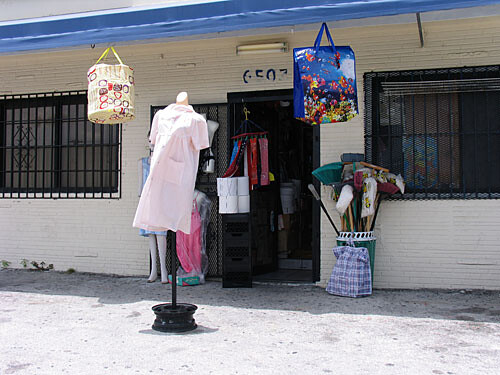

Another thing one would grow aware of when analyzing this imaginary map is the repercussions that the accumulation of these vernacular practices has over the city and how the force of repetition renders simple gestures disproportionately powerful. In this particular neighborhood, the recurring feature of the speaker in front of the store begins to help it forge a collective identity or local aura, providing new markers of reference. Beyond the rare single instance in which we find speakers used in this way (in an electronics shop Downtown or a hip new boutique in South Beach), here each speaker is part of a pattern that through its repetition becomes the very urban fabric of the place. It’s not grafted onto this fabric, as it may be in exceptional cases. Rather, here it is this fabric. Recurrence dismantles the risk of exceptionality. The string of speakers as a stand-in for a practice that is nowhere repeated in the city marks a discontinuity, but also a continuity, an internal practice of the neighborhood. It’s a rupture that happens not through a single instance of interruption but through the introduction of a new logic of usage. It is expressed in a group of artifacts, in a statistically significant set of objects. Each speaker is consubstantial with the next as the weave of a pattern. Each aids in producing a homogenized urban area, but does so in a way that renders this area different from the rest of the city. Each speaker plays a double role, then: as a figure of cohesion (internal to the neighborhood) and as a figure of disalignment (in relation to the rest of the city). It contributes to the foundation of a local identity, while simultaneously readjusting the parameters of the city’s markers as they are lodged in the particular objects considered native to it—opening a space of difference or variability toward which the city’s characteristic forms of production can, potentially, move. The speaker, then, straddles the fence, back and forth, in the binary equation between identity and difference. Or rather: it occupies each of its sides depending on the vantage point from which it is approached.
A shift to designing systems over things hasn’t thus far meant a new homogeneity for design disciplines. The systems established have been vastly different. In some cases, as in OMA’s Seattle Central Library, statistical data is used to determine the organization of a building—literally.2 Information translates into structure; diagrams morph into blueprints. In other cases, as in the projects of François Roche, algorithms are extrapolated from biological forms, in a quest for a set of active and immanent shape-making processes, and applied to building designs. As Roche explains in a 2008 interview, “in the beginning, we were thinking to integrate nature as a substance and now we integrate nature as a protocol.”3 In the parametric approaches of architects like Toyo Ito and Aranda/Lasch, rules and systems are often established and allowed to themselves generate forms. Reminiscent of the somewhat neglected practices of concrete art in which the mathematical rules established at the outset determine the final shape of the work, these practices exploit the capacity of computers employed in contemporary engineering to calculate virtually infinite numbers of variables, producing even more complex forms. The data bit and the algorithm provide flexible “building blocks” with which to erect structures suitable to urban environments that are now shaped as much by invisible flows as they are by their already existing physical structures.
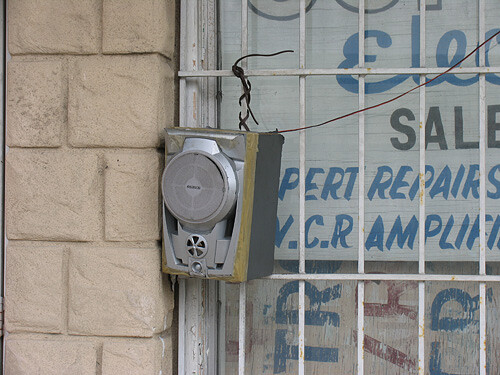

The hypothetical image of all the speakers connected together via their audio cables and electrical cables, enlivening the neighborhood with Creole and Latin music, speaks also to the particularized use to which the city’s standardized infrastructures, like its electrical system, are put when they run into the local cultures. The benefits of basic urban services as they course through the city meet diverse tastes, technical knowledge, levels of astuteness, and needs. But, above all, they meet different strategies of survival. At the precise location where the city’s electrical output meets the audio system of the shop owner, we find that turbulent intersection between the actuality of the city and the flow of new information concretized. This is one of the physical locations—one of a nearly infinite number—where the givens of the place offer specific possibilities for imported knowledge and habits to be actualized. But their actualization, the form it will take, is absolutely dependent on what the city itself offers. And what the city offers may itself, in time, change depending on the forms that the actualizations of foreign habits and knowledge take.
As a counterpoint to these applied systems, cities have their own self-organized generative systems. These are systems that emerge when new flows of energy and knowledge interact with a series of “native” constraints and pressures without extraneous guiding principles or outside agency. We find one at work in certain immigrant and marginalized neighborhoods. It can be recognized only once it has generated enough objects to populate an urban landscape densely enough to alter it.
Just as the music emanating from these speakers can be said to invade public space virtually, there is a physical invasion that accompanies it. The speakers are literally placed on public sidewalks. And with the speakers, a number of other elements are also brought out. Plants in shopping carts, sugar canes in milk crates, bouquets of brooms stuffed in trash cans, fully-dressed mannequins, exercise equipment, belt racks, chairs, clothing, flags, local newspapers, overstocked soft drinks, and all kinds of merchandise spill out beyond the shop’s walls, beyond its architectural limitations. A schematic drawing of this speaker would have to include not only the actual object, but the wiring with which it connects to the city, the systems on which it is mounted for easy transportation, the systems it is inserted into for protection. It is the combination of these three elements with the object of the speaker as a particular entity that distinguishes its use and treatment in the context of this neighborhood from how it might be understood elsewhere. If it is co-extensive with the systems into which it is introduced, it is an assemblage that folds into an even larger mise en scène that it constitutes along with the other objects (which are themselves assemblages, composed, for example, of the sugar canes in the milk crate or the plants in the shopping cart). So mannequin, merchandise, speaker, the homemade graphics, the typical (and typically patterned) bars on the windows, as well as the darkness of the space’s interiors, together form larger expressive units. Beyond simple display structures, they generate new territorial and identity markers: they are a scenery that diagrams not only the merchandise available in the store, but a certain cleverness in relation to the burdens presented by the neighborhood and the city.
A critical threshold of accumulation renders it visible, while an inventory of artifacts saturated with ingenuity solidifies its presence. It is indistinguishable from the concrete examples that embody it and through which it is expressed. It’s a system that doesn’t start with a deliberately structured form or with a population working toward an agreed-upon goal. It has no a priori guidelines or first principles. Necessity catalyzes it. Socioeconomic realities, migration patterns, imported forms of knowledge and taste, faraway geopolitical decisions and conflicts (often distant in both time and space), and other intangible factors “shape” this system and the object typologies and solutions that it generates.
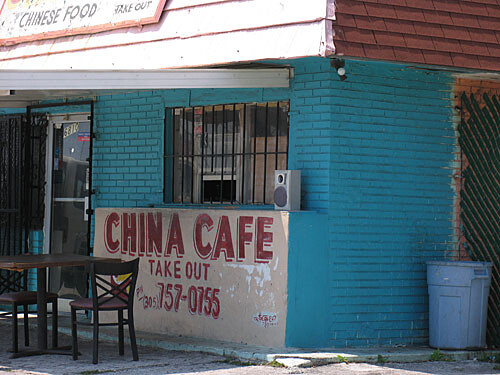

If we insist on visualizing a map of recurrences in Little Haiti, it will be noticed, too, that all these speakers are protected with improvised wire casings, mounted on casters mass-produced for large trashcans, carried in shopping carts, or tied to the building structure itself with rubber bands, tapes, chains, their own power cords, and other materials. The consistent reappearance of these traits begins to produce an archetype. It is important to point out here, however, that what matters in this situation is less the speakers themselves than the logic of reapplication that is at work. The archetype is not the recurring speakers as much as the return of an object that has been appropriated to perform a function for which it wasn’t originally designed. Reapplication is the foundational process of this system. In cases other than that of the speaker, it isn’t even any one single object that is used, but two or three seemingly incompatible ones that are brought together to produce a new artifact. The leg of a table is cemented to a flower pot; the brass headboard of a bed is used as a ladder, rubber flip-flops wedged beneath its “feet” to prevent sliding; standard PVC pipes are used to erect a veranda. The archetype, then, is the object that captures these energies of reapplication—its empirical examples are the hybrid artifacts that one bumps into around every corner, in backyards, in local shops. Unlike the traditional typologies of design—chair, bench, lamp, and so on—which are defined in relation to the way a set of recurring traits gather around a particular function (and the continuous challenging of these traits and their service to this function), the typology here is defined by the recurrence of a logic of reapplication, by the way it gathers a mass of energy and know-how. This logic of reapplication often produces strange alliances between objects, materials, and practices that few had previously thought to bring together. It creates the possibility of constantly generating unexpected solutions, loosens production from guarantees, shakes calcified practices and conventions so that they might grow reanimated again and morph.
This system seems to begin to organize itself with the introduction of immigrant populations—as flows of energy, know-how, and values—to the generally stable context of a city, upsetting the equilibrium at certain points on the map, unsettling balances, opening up zones requiring new forms of creativity in order to make them habitable. This system acquires its shape through negotiations between the application of heterogeneous knowledge and resistance to it. It’s not simply that a new population introduces foreign modes of construction into a particular site and overtakes it. The exchange is more complex: the constraints presented by the city also play a part by responding with zoning regulations and legal ordinances, existing urban layouts and infrastructures, the behavior patterns and value systems of the local population, other information and energy flows, the standard stock of materials found in its lumberyards and home improvement stores, and the structural proportions that this stock encourages. The city resists. It’s not a completely pliable site, a featureless and passive landscape, a plane onto which forms are simply grafted. The city has its say in the exchange by inhibiting certain kinds of production and encouraging others—it always presents a series of ready constraints, and can constantly generate new ones. The system emerges from this mutual exchange, on a plane of interaction and friction between new flows and established patterns, at the turbulent intersection where a new reservoir of skills meets the entrenched “way that things are done.” The system is formed by the feedback loops within these opposing forces of give and take.
Even if we can speak of a kind of freedom at ground level in which the producer can choose his/her tools, methods, and goals, there are at least two factors circumscribing this freedom. On the one hand, there is necessity. In the socioeconomic context that serves as the “natural” habitat for this system, need functions as a catalyst for production and retrofitting. It even conditions production insofar as the altering of mass-produced objects is performed as a response to immediate necessity, and not as some gratuitous figural violation. On the other hand, there is the stock of available materials and the set of established regulations that already exist in the environment that supports the system. It is in offering unexpected solutions within an already established horizon of specific materials, specific rules, and specific needs—in applying foreign knowledge and imported energy—that we find this system articulated.
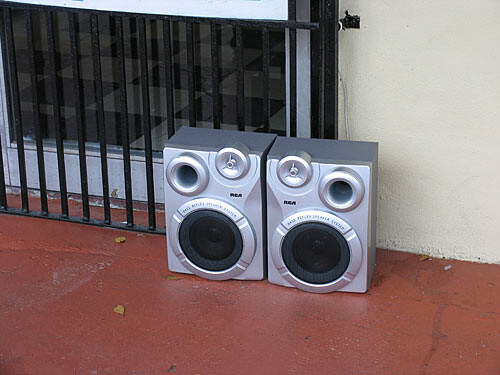

This typology also emerges as a kind of social diagram: it reveals, on the one hand, the necessities that mark the contexts from which these objects emerge. Every object is designed for a specific purpose, to respond to an immediate need. The obverse of a collection of these objects is the inventory of needs they aim to satisfy. Their logics and structures respond, almost biologically, to the conjunction of cultural exigencies and urban and socioeconomic pressures. On the other hand, they diagram the “movements” of the system’s other quasi-biological drive—its parasitical logic. If this typology inexorably functions in relation to already existing materials, if it “takes off” from the stock of available materials and applies imported knowledge to it, then we can follow the path to where this stock material is found. It is obvious that the mathematics of certain objects (the four- or eight-foot modules of standard stocks of plywood, for instance) point to the fact that home improvement stores play an important role in this mode of production.
But this articulation never finds its ultimate form. Its momentary configurations are contingent on its set of constraints—any “snapshot” of it may just describe a transitory state in the life of its changing dynamics. At any moment, new ordinances can pass, new urban features appear (a freeway bisecting a neighborhood, for instance), immigrant populations age and grow increasingly inactive or they begin to fan out into other neighborhoods, second-generation immigrants assimilate local lifestyle habits, new technologies and materials enter the market and facilitate the emergence of new vernacular practices, unexpected historical shocks produce waves that end up affecting faraway places (creating new migrations, for instance).
The relationship between flows of energy and knowledge and the actuality of the city, then, is in perpetual flux. It may strive toward a kind of balanced exchange, but new elements may emerge as a response to the interaction between the parts. And these new elements, too, are integrated into the system—they are absorbed into its internal movements. As they cause the parts to shift when they are introduced, they also force new design solutions, new concrete practices at a quotidian level. This incorporation of new elements means that the system can change in unforeseeable ways in relation to the new stimuli it encounters. Or, conversely, it reaches a terminus of variability and mutation, and disintegrates.


A map of recurrences for each of the city’s vernacular practices will reveal patterns of conduct that not only lessen the central role of more visible and guided practices such as professional architecture and industrial design, but also challenge and feed on these more visibly urban protagonists in parasitical fashion. Once the density and impact of these vernacular practices can be gauged, the mediatic fantasies of influence that architects and designers weave might just unravel.
Andrea Branzi, Learning From Milan: Design and the Second Modernity (Cambridge, Massachusetts: MIT Press, 1988), 15.
See Designboom, “Francois Roche - Interview with the French Architect,” →.